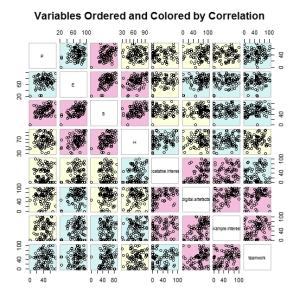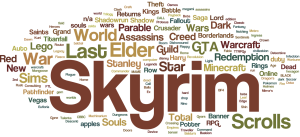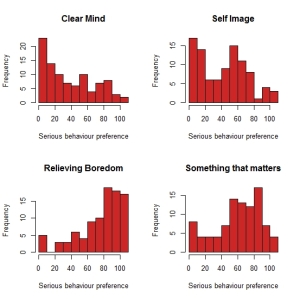Engines of Emotion
This is the text of my short presentation today:
This is my first presentation to this forum, so by way of introduction, let me explain that I’m interested in the power that video (or computer) games have, to tell stories in virtual (though ever more realistic) spaces. I want to explore what we can learn from games, as interpreters and storytellers of cultural heritage about telling emotionally engaging stories in the spaces that we look after.
First, I looked at the game mechanics that appear to drive emotional engagement with video games, and I was able to find a good deal of agreement in the literature, and at the same time group them into eight categories. Some of which – spectacle, learning, society and presence for example – cultural heritage sites can easily claim to share. Others, like acquisition, challenge, music and character aren’t things that cultural heritage does particularly well.
But the most obvious similarity between cultural heritage sites and a great many of the most acclaimed computer games is the way that both gamers and visitors explore a narrative by moving through space.
So recently I’ve been looking at cultural heritage interpretation projects that don’t just borrow ideas from game mechanics, but actually put a game on site that requires visitors move from space to space to play it and uncover the story.
For example, this is Ghosts in the Garden, designed by a company called Splash and Ripple for the Holburne Museum, Bath. It’s a sort of aural choose-your own-adventure game which encourages visitors to explore the early 19th century pleasure gardens around the museum.
And on a larger scale, this is Magic in Modern London, designed by Amblr for the Welcome Trust. It’s a sort of scavenger hunt. The user visits locations to collect virtual amulets and so uncovers the story of Edwardian folkloreist Edward Lovett. Southampton University, working with external partners, recently sought funding to build a similar location based game, exploring the events of the Southampton plot. We wanted to build an open source, non-proprietary framework, not just for this game, but to enable other cultural institutions to create their own games at minimal cost. This specific bit of research, sought to discover what game mechanics might best encourage gamers onto the street of Southampton, what social networks might best be leveraged, and also could we challenge gamers with something more sophisticated than a scavenger hunt.
Let me make clear early on, our funding bid was not successful.
I composed an on-line survey, which we distributed via the partners’ social networks, on-line gaming forums, Eatleigh’s youth network, local schools and Winchester School of art. 226 people responded, though 33 didn’t answer all the questions.
Our primary challenge became apparent with the very first question block. We asked about the respondents’ knowledge of a variety of games, on fixed devices (consoles and computers) as well mobile devices. Mobile games have an awareness issue. Eleven people had never heard of Minecraft. 178 people haven’t heard of Ingress, a location based game that according to some sites, including Android Headlines on 4th December 2012, is “taking the world by storm.” Just 32 people said they’ve played a game that uses their device’s location.
So, we asked them what game they enjoyed most recently:
With its open world, layers of (made up) history, and research quests, Skyrim is close to many an archaeologist’s heart, and proved popular with our correspondents. But of course different people like different things, and so I wanted to see if they was a particular “type” of gamer who might be more attracted than others to the open and real world, location based game that we were proposing. The most famous classification of gamer motivations is Richard Bartle’s 1996 paper. However that is actually based on players of just one genre of on-line gaming, and has limited application beyond that.
So the taxonomy I settled on for this research was that of Nicole Lazarro. Drawing on the work of anthropologist Paul Ekman, Lazzarro and her team recorded the facial expressions of volunteers playing different types of games. The conclusion of their study was a classification of four type of fun:
Hard Fun – The emotion that the team observed here was fiero, an italian word borrowed by Eckman because decribes the personal feeling of triumph over adversity, an emotion for which there is no word in English. And the game mechanics that unlock that emotion (and possibly on the way, the emotions of frustration and boredom too) are: goals; challenge; obstacles; strategy; power ups; puzzles; score and points; bonuses; levels; and, monsters.
Easy Fun – Curiosity is the main emotion evident in the Easy Fun style of play, though surprise, wonder and awe were observed too. The game mechanics that define this style of play are: roleplay; exploration; experimentation; fooling around; having fun with the controls; iconic situations; ambiguity; detail; fantasy; uniqueness; “Easter Eggs”; tricks; story; and, novelty.
Serious Fun – What is the most common emotion observed with Serious Fun mechanics? Relaxation! The game mechanics that take players to that state are: rhythm; repetition; collection; completion; matching; stimulation; bright visuals; music; learning; simulation; working out; study; and real-world value. It’s this last mechanic that explains why its called “serious” fun. People playing in this mode also seem more ready to attach a value to their participation in the game outside the game itself – brain-training, physical exercise, developing skills or even a conscious effort to kill time (think of those people playing Candy Crush on the train)
People Fun – Happiness comes with People Fun, Lazzaro’s team observed “amusement, schadenfreude (pleasure in other people’s misfortune) and naches (pleasure in the achievements of someone you have helped)” among players in this mode. Among the he long list of game mechanics that get people there are: cooperation; competition; communication; mentoring; leading; performing; characters; personalisation; open expression; jokes; secret meanings; nurturing; endorsements; chat; and gifting.
I used some of the evidence Lazarro had gathered to create a number of Likert agreement scale questions, which might, in combination, indicate respondents’ preferences for the four different types of fun.
This example shows how people responded to the questions about what Lazarro called Serious Fun.

And this slide shows how the combined responses to the questions indicate the cohorts’ preferences for the four types of fun. You will note that Easy Fun, which includes a preference for narrative or story based games, is the highest scoring in this sample. I was very encouraged by this. I was hoping that I’d see s correlation between a preference for Easy Fun and another Likert question we asked about interest in a locatative game.

However this correlation matrix shows no relationship between respndents’ preference for Easy Fun and their expressed interest in locatative games. There is, however, a possible relationship between gamers’ preference for Hard Fun.

However, on closer inspection of that relationship, the confidence intervals shown in this scattergram, show me I can’t disprove the null hypothesis. Now I should state that the number of respondents who answered all the questions required for this analysis was less that half the total number of completed surveys, just 94. So it may be that a larger sample size would better enable me to prove or disprove the null hypothesis. But the more worrying observation is this one – a large proportion of this sample expressed zero interest in games involving the player’s location. Which resonates with the earlier observation that there was very little recognition or awareness of of such games. So it may be that most people don’t want to play games that use their real world position, or that idea is yet to have it’s moment.
Either way it strikes me I’d be better off investigating how some of games’ engagement drivers could improve cultural heritage interpretation, rather than rushing to import locatative games wholesale into the cultural heritage space.



